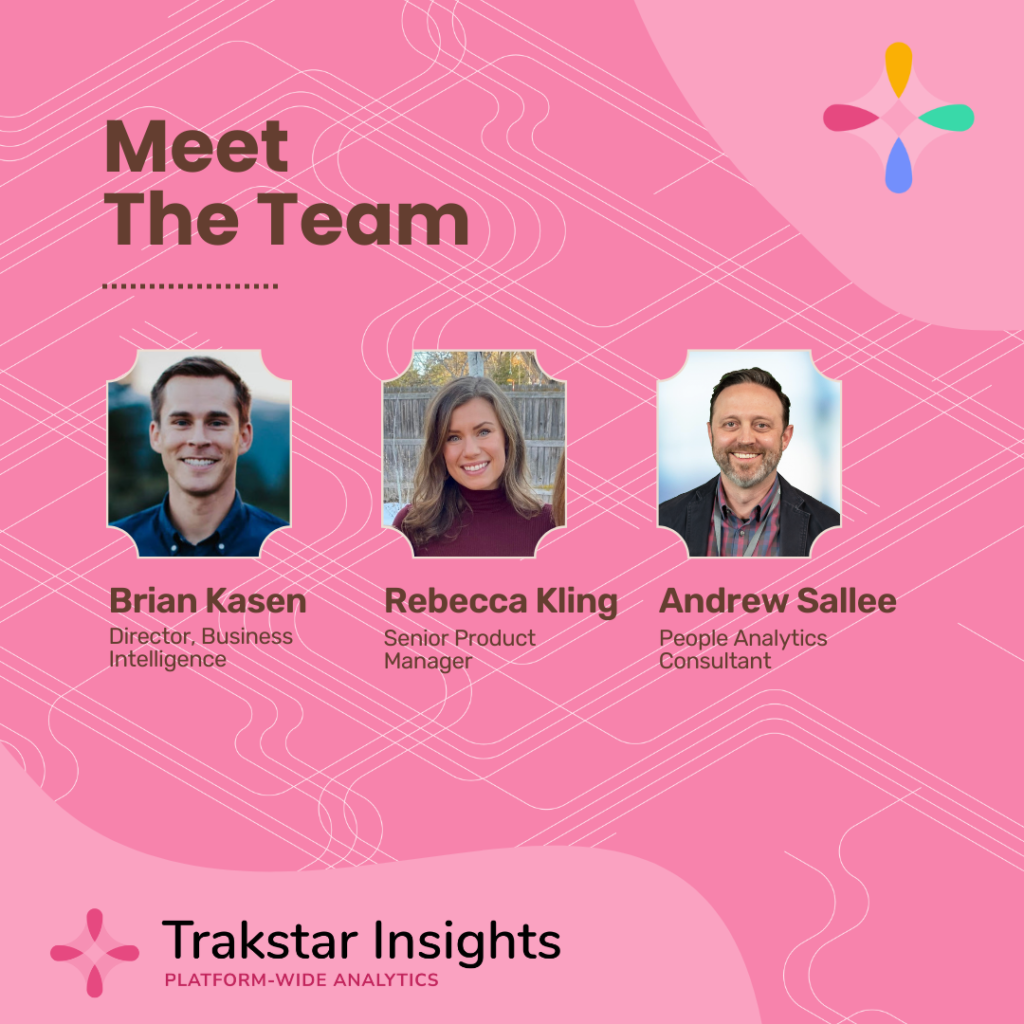What is Benchmarking: FAQs Answered
Posted by Trakstar • August 1, 2022 (Last modified August 9, 2022) • 7 min read
Soon, Trakstar Insights is going to be unveiling its newest feature: Benchmarking for Trakstar Perform. For this blog, we’ll talk to some of the team behind Trakstar Insights and Benchmarking to get their take on what benchmarking is, why HR leaders need it right now, and how it will change the way we look at talent development.
What is Benchmarking?
Benchmarking allows you to compare your data with aggregated data from other companies who share their data. This provides valuable context, helping you to set meaningful targets, gain insight into trends occurring across your peer group, and find out how you are doing compared to your competition.
Let’s dig a little deeper into the product with some help from Brian Kasen, Rebecca Kling, and Andrew Sallee, all people shaping Trakstar Insights and benchmarking, in particular.

What Are The Different Types of Benchmarking – and What Does Trakstar Perform Benchmarking Unlock?
In business, there are different types of benchmarking that companies undergo to know where they stand against their competitors and peer groups. Insights benchmarking gets a little deeper into specific comparisons to help HR leaders understand what’s working and what isn’t in relation to performance. Andrew explains, “Perform Benchmarking surfaces recent trends for employee retention by performance groups and tenure and offers a comparison to peers within your industry and among other companies of similar size.”
Rebecca continues, “For this iteration, we will be benchmarking on a quarterly basis, and comparing organizations to two different peer groups. The first is by industry, and the second is by company size.”
How Much Work Will HR Leaders Need To Do For Benchmarking?
We know that HR leaders have enough work, so the idea of benchmarking might seem a little scary. It’s not! With Insights, HR leaders will have to do very little work. Brian says: “Based on your recent trends, the analysis gives you the key talking points to accompany the dashboard visuals, and offers guided recommendations on what to do next.”
According to Andrew, there won’t be additional work for HR leaders who already use Trakstar: “There are no additional steps to set up or access Perform Benchmarking. Perform Benchmarking gives you “presentation ready” insights into recent employee retention trends across performance and tenure groups and compared to industry peers. Take views directly from the dashboard into executive presentations.”
Why Do HR Leaders Need Benchmarking?
HR leaders need benchmarking for a variety of reasons. Andrew explains: “Competition for talent and care for people have been steadily rising topics for business leaders in recent years. It can be difficult to know how much is enough when pushing in new directions within a dynamic landscape. Benchmarking allows HR leaders to inform the entire organization where performance and talent management efforts are achieving results and where the business needs to push harder to improve.”
Does this sound like something your business needs? Then Benchmarking might be the answer to your problems.
How Can Other People, Like the C-Suite, Use Benchmarking?
Executives across business domains desire to know more about the vital asset, which is their people. Perform Benchmarking is ready-made to inform executives and board members about retention trends of top-performing and tenured talent and how your company trends compare within your industry.
Perform Benchmarking offers concise (but thorough) comparisons to inform conversation and action-taking across the C-Suite. How is our company doing in retaining top-performing talent? How do we compare to other companies like us? These questions are now at the fingertips of executives across the enterprise.
How Can HR Leaders Use Benchmarking in Performance Management?
Andrew explains how Perform Benchmarking enables HR leaders to move the performance management process beyond an annual HR to-do item and to connect performance management directly to the vital topic of employee retention. “HR leaders can easily witness important recent trends in employee retention and portray how those trends play out among highest and lowest performing employee groups. This core intelligence about talent and performance connects directly to the next conversations about employee engagement and compensation that HR must orchestrate with business leaders.”
This is a tool that HR leaders have been looking for to make their performance reviews better, align expectations across the workforce, and show the work they’re doing.
What Are Some Benchmarking Examples?
Rebecca explains what you can expect in Perform Benchmarking dashboard, “We are benchmarking your organization’s retention rates across two different peer groups: industry and company size. You will be able to see how your retention rates compare over time, across performance groups, and across employee tenure groups. We will also give you insights into how to maintain positive trends or address areas for improvement.
Brian gives one example that HR leaders might be looking for: “HR leaders will be able to measure your quarterly retention trends, compared to your industry, and then what action is required.”
What Are Some Best Practices Surrounding Benchmarking?
Using benchmarking effectively requires consistency and collaboration.
- Analyze Often: Form habits of reviewing Perform Benchmarking at a quarterly cadence as part of other planning or business review events.
- Share Key Trends: Discuss industry and company size comparison concepts with business collaborators. Are these meaningful comparisons for your business? Create opportunities for leaders and team members to ask questions or voice concerns.
- Establish Goals: Set goals in light of the benchmarks. Based on your company’s performance and the level of importance for competitive comparisons – where do you want to be compared to where you are now?
How can Benchmarking Insights be Utilized Across the Organization?
Benchmarking will be useful in several settings over the course of the annual business calendar:
- Annual and quarterly business reviews
- Performance cycle planning and review
- Annual or quarterly board of directors meetings
- Quarterly leadership meetings
Perform Benchmarking shows quarterly trends of employee retention connected to employee performance and compared to industry peers and competitors. Your company trends should be a regular part of strategy and planning touchpoints ongoing.
What Will Benchmarking Look Like in Trakstar?
Rebecca hints at what Trakstar users can expect: “The benchmarking dashboard will be directly embedded in the product and available to all admins! You can find this dashboard under the “Insights” tab, where you will also see the other Insights dashboard available to you.”
How Can HR Leaders Use Benchmarking in Hiring?
Hiring is full of transactions and measurements. How many applications have we received? How many interviews have we conducted? How long does it take us to fill open jobs? That’s just the start! HR leaders are expected to pull statistics quickly and it can be difficult to do so.
Hiring Benchmarking will provide comparisons to better understand the effectiveness of your hiring efforts next to other companies in your industry and of your same size. Benchmarking for Trakstar Hire will follow later this year, we are targeting late Q3 for release.
How Can I Find Out More About HR Benchmarking with Trakstar?
Right now, retention is the hottest topic in human resources. How can we retain the workers that we have? SHRM has estimated that it will cost nearly $30,000 to recruit and train someone to replace a manager who makes $40,000 a year. This doesn’t account for the loss of time, resources, productivity, and the impact it makes on the rest of your workforce. Low retention rates cause a ripple effect throughout your organization. Before employees quit, there are signs that you can notice, but HR leaders are so busy that there often isn’t time.
It’s important to know that nearly 80% of the reasons behind employee turnover can be spotted and prevented. The key is identifying what those issues are and spotting the employees who are thinking about leaving early. Performance management is one of the most impactful ways to do this, and Benchmarking for Trakstar Perform takes it a step further.
To find out more about the Trakstar platform, schedule a demo today. If you are already using Trakstar, you will see Benchmarking on your Insights dashboard soon.
Don't Miss Out on More Great HR Articles!
Subscribe to get the latest, greatest HR and Talent Development content straight to your inbox.


